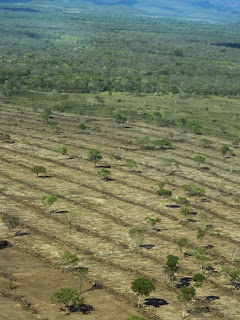Chlorofluorocaron or CFC is an organic compound that contains Carbon, Chlorine, and Fluorine. It has extremely long atmospheric lifetimes and is the main cause of stratospheric ozone depletion. CFCs are produced for the purpose of refrigeration and spray can propellants, and enormously used over the years! Although naturally there is very little chlorine in the atmosphere, it turns out that CFCs are a brilliant of introducing chlorine into the ozone layer. Why? Because when the ultraviolet radiation reaches atthis altitude, it breaks down CFCs and frees the chlorine. Under the appropriate conditions, then, the chlorine will attach to one oxygen atom from ozone molecule (O3), becoming Chlorine monoxide (ClO) and leaving one ordinary oxygen (O2) molecule. Moreover, when ClO faces a free oxygen atom (O), the oxygen of ClO bonds with the free oxygen, creating an ordinary oxygen molecule (O2), and freeing chlorine to the atmosphere. Thus, one chlorine atom can destroy thousands of ozone molecules. That's why chlorine has the potential to destroy large amount of ozone. As a result, levels of genetically harmful ultraviolet radiation have increased.
Another important aspect that we have to take into consideration is Deforestation.
Not only do humans release these gases to the atmosphere, but we also destroy ‘the lung of the world’. Why I say ‘lung’? Because trees plays a critical role in absorbing the greenhouse gases that fuel global warming and release oxygen which benefits to all living things. When we cut down the trees, the best source for living of all creatures – food, habitats, clothes, and medicine--, for the benefits of ourselves, we wipe out the ‘helper’ to suck up greenhouse gases entering the atmosphere, so this increases the speed and severity of global warming. According to FAO of United Nations, 4 September 2006, Rome – Most people assume that global warming is caused by burning oil and gas. But in fact between 25 and 30 percent of the greenhouse gases released into the atmosphere each year – 1.6 billion tonnes – is caused by deforestation. Trees are 50 percent carbon. When they are felled or burned, the CO2 they store escapes back into the air. FAO, 2008. Deforestation causes global warming.
The question is what is the biggest driver of deforestation?
1) The need for fuel
2) Agriculture
3) Road building
According to National Geographic, the biggest driver of deforestation is agriculture. So, congratulations for anyone who chooses 2)! They say “Farmers cut forests to provide more room for planting crops or grazing livestock. Logging operations, which provide the world’s wood and paper products, also cut countless trees each year. Loggers, some of them acting illegally, also build roads to access more and more remote forests—which lead to further deforestation. Besides, there is a combination of human and natural factors like wildfires and subsequent overgrazing, which may prevent the growth of young trees.
 |
Pantanal Deforestation Photograph by NicoleToken trees dot Brazil's Pantanal wetland where dense forest used to stand. Considered the world's largest wetland, the Pantanal is an ecological paradise that covers 54,000 square miles (140,000 square kilometers) in Brazil, Bolivia, and Paraguay, and supports thousands of animal species. http://environment.nationalgeographic.com/environment/photos/rainforestdeforestation/#/pantanal-deforestation_332_600x450.jpg |
 |
| Illegal Logging Site Photograph by Timothy G. Laman
A clearing in Gunung Palung National Park in Indonesian Borneo reveals an illegal logging operation, where loggers fell and mill trees into lumber on site. Deforestation in this area threatens the endangered orangutan population. http://environment.nationalgeographic.com/environment/photos/rainforest-deforestation/#/illegal-logging_205_600x450.jpg
|
 |
Malagasy Slash-and-Burn Photograph by John Michael Fay
|
Scars of bald earth, exposed by slash-and-burn deforestation, encroach on the forests of northeastern Madagascar. Economic pressures have driven the government to exploit one of the most biologically rich areas on Earth for cultivation of coffee beans.
Your blog is very easy to understand,I will follow you.
ReplyDeleteThis video is so cute,I like it.
ReplyDelete